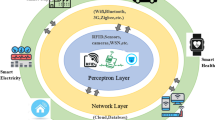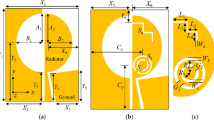Abstract
In cognitive radio network, the secondary users (SUs) use the spectrum of primary users for communication which arises the security issues. The status of SUs as legitimate users is compulsory for the stability of the system. This paper addresses the issue of delay caused by a band-selection decision process that directly affects the security and performance. The model cluster-based distributed cooperative spectrum sensing is proposed. In this model, cluster heads (CHs) exchange control information with other CHs and ordinary nodes. This model significantly reduced the delay, sensing, convergence, routing, in band-selection process. This also reduces the energy consumption while sensing the spectrum which seriously leads to performance upgradation. The simulated results show the improved performance of cognitive radio networks in terms of delay, packet loss ratio and bandwidth usage as compared to cluster-based cooperative spectrum sensing model. The opportunity for primary user emulation attacker is minimized as the overall delay is reduced.









Similar content being viewed by others
References
Devroye N, Vu M, Tarokh V (2008) Cognitive radio networks. IEEE Signal Process Mag 25(6):12–23
Carrillo D (2017) Cognitive radio networks. In: Cognitive technologies. Springer, Cham, pp 95–109
Ali A, Hamouda W (2017) Advances on spectrum sensing for cognitive radio networks: theory and applications. IEEE Commun Surv Tutor 19(2):1277–1304
Beibei KJ, Wang Liu (2011) Advances in cognitive radio networks: a survey. IEEE J Sel Top Signal Process 5(1):5–23
Wang J, Huang Y (2010) A cross-layer design of channel assignment and routing in cognitive radio networks. In: IEEE international conference on computer science and information technology (ICCSIT), vol 7, pp 542–547
Pandit S, Singh G (2017) Spectrum sensing in cognitive radio networks: potential challenges and future perspective. In: Spectrum sharing in cognitive radio networks. Springer, Cham, pp 35–75
Akyildiz IF, Lee W-Y, Vuran MC, Mohanty S (2006) NeXt generation/dynamic spectrum access/cognitive radio wireless networks: a survey. Comput Netw 50(13):2127–2159
Steenkiste P, Sicker D, Minden G, Raychaudhuri D (2009) Future directions in cognitive radio network research. NSF Workshop Rep 4(1):1–2
Steenkiste P, Sicker D, Minden G, Raychaudhuri D (2009) Future directions in cognitive radio network research. NSF Workshop Rep 4(1):1–2
Ayzed Mirza M, Asif Habib M, Muhammad (2017) Optimized energy ingestion in IoT enabled sensor nodes: a survey. J Softw Eng Intell Syst 2(3):3
Basumatary N, Sarma N, Nath B (2018) Applying classification methods for spectrum sensing in cognitive radio networks: an empirical study. In: Advances in electronics, communication and computing. Springer, Singapore, pp 85–92
Akyildiz IF, Lo BF, Balakrishnan R (2011) Cooperative spectrum sensing in cognitive radio networks: a survey. Phys Commun Sci 4(1):40–62
Karthikeyan CS, Suganthi M (2017) Optimized spectrum sensing algorithm for cognitive radio. Wirel Pers Commun 94(4):2533–2547
Chen Q, Wan P, Wang Y, Li J, Xiao Y (2017) Research on cognitive radio spectrum sensing method based on information geometry. In: International conference on cloud computing and security. Springer, Cham, pp 554–564
Shahrasbi B, Rahnavard N, Vosoughi A (2017) Cluster-CMSS: a cluster-based coordinated spectrum sensing in geographically dispersed mobile cognitive radio networks. IEEE Trans Veh Technol 66(7):6378–6387
Awin FA, Abdel-Raheem E, Ahmadi M (2014) Agile hierarchical cluster structure-based cooperative spectrum sensing in cognitive radio networks. In: International conference on microelectronics (ICM), pp 48–51
Hu Z, Bai Y, Cao L, Huang M, Xie M (2018) A sequential compressed spectrum sensing algorithm against SSDH attack in cognitive radio networks. J Electr Comput Eng 2018:1–9. https://doi.org/10.1155/2018/4782718
Tang H, Vasilakos AV, Yu FR, Leung VCM, Attar A (2012) A survey of security challenges in cognitive radio networks: solutions and future research directions. Proc IEEE 100(12):3172–3186
Zheng M, Liang W, Yu H, Song M (2016) SMCSS: a quick and reliable cooperative spectrum sensing scheme for cognitive industrial wireless networks. IEEE Access 4:9308–9319
Grissa M, Yavuz AA, Hamdaoui B (2017) Preserving the location privacy of secondary users in cooperative spectrum sensing. IEEE Trans Inf Forensics Secur 12(2):418–431
Niranjane PK, Wadhai VM, Rajput SH, Helonde JB (2015) Performance analysis of PUE attacker on dynamic spectrum access in cognitive radio. In: International conference on pervasive computing (ICPC). IEEE, pp 1–6
Anand S, Jin Z, Subbalakshmi KP (2008) An analytical model for primary user emulation attacks in cognitive radio networks. In: 3rd IEEE symposium on new frontiers in dynamic spectrum access networks, DySPAN 2008, pp 1–6
Chen C-Y, Chou Y-H, Chao H-C, Lo C-H (2012) Secure centralized spectrum sensing for cognitive radio networks. Wirel Netw 18(6):667–677
Jiao Y, Yin P, Joe I (2016) Clustering scheme for cooperative spectrum sensing in cognitive radio networks. IET Commun 10(13):1590–1595
Cichon K, Kliks A, Bogucka H (2016) Energy-efficient cooperative spectrum sensing: a survey. IEEE Commun Surv Tutor 18(3):1861–1886
Tang W, Li S, Yu H (2011) Optimization of cooperative spectrum sensing with sensing user selection in cognitive radio networks. EURASIP J Wirel Commun Netw 2:208
Zou Q, Zheng S, Sayed AH (2010) Cooperative sensing via sequential detection. IEEE Trans Signal Process 58:6266–6283
Noh G, Wang H, Jo J, Kim BH, Hong D (2011) Reporting order control for fast primary detection in cooperative spectrum sensing. IEEE Trans Veh Technol 60(8):4058–4063
Mishra V, Mathew J, Lau C-T (2017) Introduction: QoS and energy management in cognitive radio network. Springer, Cham, pp 1–37
Akyildiz IF, Lee W-Y, Vuran MC, Mohanty S (2006) NeXt generation/dynamic spectrum access/cognitive radio wireless networks: a survey. Comput Netw Sci 50:2127–2159
Miah MS, Yu H, Godder TK, Rahman MM (2015) A cluster-based cooperative spectrum sensing in a cognitive radio network using eigenvalue detection technique with superposition approach. Int J Distrib Sensor Netw 92
Kishore R, Ramesha CK, Sawant T (2016) Superior selective reporting mechanism for cooperative spectrum sensing in cognitive radio networks. In: International conference wireless communications, signal processing and networking (WiSPNET), pp 426–431
Leon O, Subbalakshmi KP (2017) Cognitive radio network security. In: Handbook of cognitive radio, pp 1–30
Mapunya S, Velempini M (2018) Investigating spectrum sensing security threats in cognitive radio networks. In: Ad hoc networks. Springer, Cham, pp 60–68
Rehman A, Prakash D (2017) Detection of PUE attack in CRN with reduced error in location estimation using novel bat algorithm. Int J Wirel Netw Broadband Technol (IJWNBT) 6(2):1–25
Malhotra M, Aulakh IK (2016) Secure spectrum leasing in cognitive radio networks via secure primary secondary user interaction. In: Artificial intelligence and evolutionary computations in engineering systems. Springer, New Delhi, pp 735–741
Chaitanya DL, Chari KM (2017) Performance analysis of PUEA and SSDF attacks in cognitive radio networks. In: Computer communication, networking and internet security. Springer, Singapore, pp 219–225
Sultana R, Hussain M (2018) Mitigating primary user emulation attack in cognitive radio network using localization and variance detection. In: Proceedings of first international conference on smart system, innovations and computing. Springer, Singapore, pp 433–444
Sharifi M, Sharifi AA, Niya MJM (2018) Cooperative spectrum sensing in the presence of primary user emulation attack in cognitive radio network: multi-level hypotheses test approach. Wirel Netw 24(1):61–68
Marinho J, Granjal J (2015) Monteiro E (2015) A survey on security attacks and countermeasures with primary user detection in cognitive radio networks. EURASIP J Inf Secur 1:4
Zhang J, Cai L, Zhang S (2017) Malicious cognitive user identification algorithm in centralized spectrum sensing system. Future Internet 9(4):79
Pandit S, Singh G (2017) Cognitive radio communication system: spectrum sharing techniques. In: Spectrum sharing in cognitive radio networks. Springer, Cham, pp 1–33
Venkatesan KJP, Vijayarangan V (2017) Secure and reliable routing in cognitive radio networks. Wirel Netw 23(6):1689–1696
Bhargavi D, Murthy CR (2010) Performance comparison of energy, matched-filter, and cyclostationarity-based spectrum sensing. In: Eleventh international workshop on signal processing advances in wireless communications (SPAWC). IEEE, pp 1–5
Author information
Authors and Affiliations
Corresponding author
Rights and permissions
About this article
Cite this article
Mirza, M.A., Ahmad, M., Habib, M.A. et al. CDCSS: cluster-based distributed cooperative spectrum sensing model against primary user emulation (PUE) cyber attacks. J Supercomput 74, 5082–5098 (2018). https://doi.org/10.1007/s11227-018-2378-6
Published:
Issue Date:
DOI: https://doi.org/10.1007/s11227-018-2378-6




